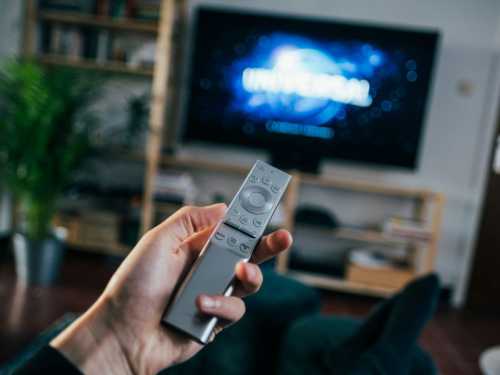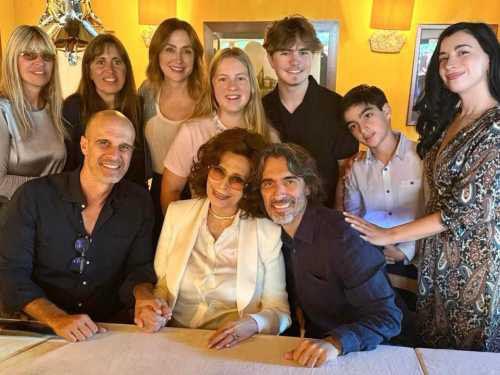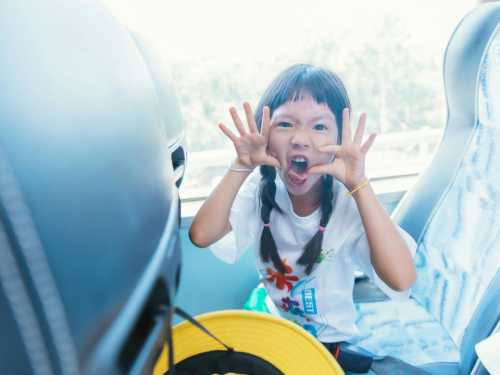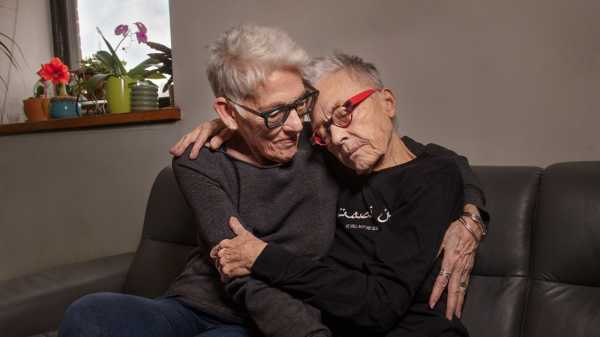
“I’m glad you made it at the last minute,” Barbara Hammer said when I arrived at the West Village apartment where she lives with her spouse, the human-rights activist Florrie Burke. Hammer is dying. At seventy-nine, she has lived with cancer for thirteen years and has exhausted all available treatment options. She has spoken publicly, repeatedly, about her impending death, both as an artist reflecting on her creative life and as an activist for allowing terminally ill patients to take charge of the dying process.
Hammer is a pioneering visual artist known primarily for her films, most of which deal with lesbians, personal histories, and the body. Her four-minute film “Dyketactics,” from 1974, is a classic of lesbian hippie joy; her first feature, “Nitrate Kisses,” from 1992, was a visual and sensual exploration of hidden lesbian histories. Most of Hammer’s work is nonlinear, based on striking connections that she draws among disparate facts, images, movements, and sounds. Hammer appears in many of her own movies: she speaks, dances, and asks a lot of questions. With retrospectives at the Museum of Modern Art, in New York, and the Tate Modern, in London, among other venues, she is probably the first artist to have achieved mainstream acclaim for a lifetime of work done as a lesbian, largely about lesbians.
I asked Hammer if she would sit for an “exit interview,” and she found the idea delightful. We spent two mornings together, in February. Because both the disease and the drugs that she is taking for pain are affecting her ability to use language, Hammer at times asked Burke to step in when she couldn’t find the words to describe images she could see clearly in her mind. The arrangement made it easier to talk about the events, ideas, and work to which Burke has been a witness, though earlier decades of Hammer’s life were harder for her to describe. This interview has been condensed and edited for clarity.
Day 1
Let’s start by talking about your activism for death with dignity. How did that start?
HAMMER: When I became aware that I really was dying, and it was going to be soon. How could I die in a way that would alleviate pain and allow me to say goodbye to people that I want to, and make sure all my artifacts are in order? With the assistance of a physician, I could be able to take the pills that will put me out of my suffering and pain. People do their best, they are working with me in palliative care, but it can take thirty minutes to an hour to get the interventions that alleviate the suffering. And the suffering is pretty awful. I can’t say I’m not yelling, wanting to jump out the window sometimes. In New York State, it is illegal for somebody to assist me in dying.
BURKE: We’ve always been believers in choice. We have a good friend who advocated for it in Washington, D.C., for two years, and she actually was the first person who could use it there. She died in August. She also had ovarian cancer. We’re hoping people will get onboard and push New York to pass the Medical Aid in Dying Act, so that people have a choice. [In 2018, the New York State Assembly considered a right-to-die law that didn’t make it through committee, but activists continue to work toward legalizing aid in dying; the bill has been introduced again.]
HAMMER: We looked into further possibilities. We have family in Oregon.
BURKE: And California.
HAMMER: But you have to live there for two years before you establish residency, and have doctors in agreement. Also, you don’t have your circle of friends and family.
BURKE: And we looked into the Switzerland idea, but that seemed even more isolating.
HAMMER: More isolating and expensive. Then you start thinking, Oh, my God, I could give my nephew that money to go to school with—can’t I suffer a few more weeks?
How long have you been in palliative care?
HAMMER: A long time, since May. But, even then, I was able to work. I did the lecture “The Art of Dying or (Palliative Art Making in the Age of Anxiety).” Did it three times [at Temple University, at Yale, and at the Whitney Museum, in New York City], always improving it and always noting that my abilities are declining slowly. Also, an exhibition that I’m in required writing—I could go out and do the shooting, but a couple of weeks later, when we got to the language, I couldn’t do it. My assistant was very helpful. The wonderful thing about dying is the interesting processes. I find it fascinating as an artist and as a writer. Your ability to talk in the world is changing. And you still remember what you used to be able to do. I can’t read, but I can still listen to Florrie read to me. I can still listen to the radio. There are things that I can delight in. Just to see the changes is what I always wanted. What is it like to die? Why don’t we know? I try to take notes on it. It is harder to write now. I don’t really feel like going into so many details when pain hits hard, though I kind of feel like I should. I mean, what am I? An investigator, an archeologist.
So much of your work has been about two things: about investigating the body—the sexual body—and also trying to tell your own story in different ways, through looking for your roots: as a lesbian, as somebody whose family came from Ukraine, as an artist. In “Tender Fictions,” you start by saying that you read artists’ autobiographies to figure out how to be an artist.
I read these books on Gauguin and other extraordinary male artists, identifying with them as artists at kind of the extreme edges: they leave their family, they go to another country, they would live without much money, suffer, and do these fantastic works. That was my role model. I didn’t have any women. At that point, I hadn’t taken a film class, so I really didn’t know some women I could have looked up. But then I started taking film classes at Sonoma State and driving my motor scooter there and studying with William Morehouse, who started the art program at the San Francisco Art Institute.
I would take over a room and just paint in the whole room by putting glass and paper all the way around the room. One day, I brought Morehouse in. He recognized me—this is all you want, as a young artist, is to be recognized. He had long talks with me then. “It may be very hard to be an artist. You might have to make twenty works in one year. Do you really want to do this?,” he asked. “Yes, I still want to do it.” “You may not be recognized for twenty years.” “That’s where I’m going.”
You’ve said that you heard the word “lesbian” for the first time at the age of thirty. This would have been around 1970, at the height of lesbian activists’ battle for recognition among mainstream feminists.
HAMMER: I was living in a house in the woods, in Northern California. I listened to KPFA [the listener-supported Berkeley radio station], and I heard a critique of the Miss America contest. When my husband and his friend came back, I said, “Guess what, I became a feminist.”
From listening to KPFA.
HAMMER: My husband got very upset, very grouchy, and Ralph, who is my friend and his friend, was thrilled: “Oh, great, Barbara, terrific.” It made a big mark on me.
The neighbor across the street was afraid of me playing with his kids. He said, “I think you might be queer.” I said, “What does that mean?” And he said, “Well, I know you never wear a skirt, but it’s just the way that there is some behavior that does make me uncomfortable and makes me feel as if you might be interested in my children.” Everybody’s stories probably are quite grotesque, but that’s just one of them.
But it sounds like it was a very joyful discovery—you’ve said that you were a lesbian adolescent in your thirties.
HAMMER: I got out of the marriage in about a year. I took with me my little Volkswagen and a tape recorder, and put it in my car along with a crazy dress. Then I started living in Berkeley and somebody gave me a Super-8 camera and I made a lot of films. I would do something crazy. I would hitchhike up and down College Avenue and then I would tape-record people inside the car, what they thought of me, what it was like living there. I would get to the end of the street, get out, come back the other way interviewing people. I went to Gay Pride and walked around interviewing people about what an orgasm felt like. And, you know, I would find some who would participate. But the audio didn’t come out, because it was so noisy at the festival. You could call it eccentric. You have an idea—you try it. Those are the processes that I followed at that time. I would write my name and address and put them in a balloon for people to find. Because otherwise I’d be lost in the world.
You and Florrie have been together for thirty-one years. So you weren’t that young when you got together.
BURKE: I was in my mid-forties. She was late forties.
How did you meet?
BURKE: The West Coast Women’s Music Festival, in Yosemite.
Classic.
BURKE: Naked.
You were naked when you met?
BURKE: Yes. And we were with other people and I was shy. I was shy until I got with Hammer—and then you can’t be.
HAMMER: That was at a new place in life, where I finally decided I did not want to have more relationships. I wanted to have one. I wanted to find out what it’s like to take one person and go all the way. And that’s what I’ve been able to do thanks to both of us putting up with each other.
BURKE: And that’s what I didn’t want at the time.
You didn’t want a monogamous relationship, or a lifelong one?
BURKE: I didn’t want a long term. I said, “I just want to have a fling, and I hear you’re a great one for that,” because she had a big reputation of three months, six months. And people said, “Don’t go out with her—she’ll break your heart. She’ll dump you in a few months.” Here we are.
HAMMER: I knew there would be hardships. There would be things I’d have to change and I couldn’t be who I was always and I had to learn how to love in ways that I hadn’t before. It’s been a long process. We both have been through cancer. We both have seen each other through, Florrie with the largest commitment to a long period. Thirty years of being with me. You can imagine the struggles a person can have.
I went through a year and a half of Florrie in extreme pain. It was very hard. And I just didn’t know if I could do it.
You didn’t know if you could take care of her?
HAMMER: Yes. And, of course, she would probably like to just beat it out of here and be somewhere else. How could she not? You know the restriction, maybe you’ve been in that . . .
BURKE: The caregiving, the constancy of it.
HAMMER: You lose yourself.
BURKE: In 2015, I had spine surgery, and, as soon as I got through my rehab and was really good and strong, I said, “O.K., now, we can get back to doing what we always do,” which was a very active life. And then Barbara got this horrendous diagnosis that her tumors had metastasized to her lungs. And so we started down that path again, of chemo and treatment, and that went on until she started palliative care.
She’s had a hundred chemo treatments over twelve years and immunotherapy and surgeries. Everything that you could do was done.
HAMMER: It really has been a lot. But so much pleasure, so much travel, so much exploring. A few times of working together that never really worked out.
BURKE: We didn’t do it so well.
What happened?
HAMMER: We both are powerhouses.
BURKE: Control freaks.
HAMMER: Have different ideas about the way a film should work—even if Florrie hasn’t made a film.
But you still tried it more than once?
HAMMER: Yes. We did [a film about] women who drove around the world looking for breast cancer. “The Nancy Drew Stories.” We wrote it, we got together a crew—and we didn’t get the funding. And then—
BURKE: —Deaf people with H.I.V. and AIDS. That’s being finished now. Barbara got a grant from the Wexner Center to finish five unfinished works. She wasn’t well enough to finish them. And she had an idea: What if I choose a filmmaker that I think would be appropriate for each of the five? Can they have the money to finish the work? And they went for it. The date is this summer to finish. One was the one about deaf people with AIDS, and, yes, I worked on that with you. That was fun. We didn’t have struggles over that.
HAMMER: Another one of the unfinished films was shot in 1975, in Guatemala. I rode a motorcycle down there, a BMW, all by myself. I wanted to understand the way the indigenous Indians used their clothing. I couldn’t figure out how to make this of interest, until I thought, Oh, I’ll look more at the way that—can you help me?
BURKE: I think you were looking at modernization and you wanted to go back . . .
HAMMER: Yes.
BURKE: . . . to those markets and see . . .
HAMMER: Yes.
BURKE: . . . how everything is now mass-produced and is no longer . . .
HAMMER: Yes. Yes.
BURKE: . . . hand-woven.
HAMMER: Yes.
BURKE: And the different—the different weaves for each group . . .
HAMMER: Yes.
BURKE: . . . within the culture.
HAMMER: Right.
BURKE: And how the market way, way up in the hills was so different from the other markets.
HAMMER: Yes. Yes.
BURKE: Because they didn’t have all the plastic stuff.
HAMMER: Thank you. Another very simple work that is being given away to a filmmaker I respect brings in my very sexual images. I have taken my clothes off. Nobody is with me, from what I could tell. You just see the shot from here to here [motions to the area from her upper thighs to the waist], along with the countryside around me, on a hill somewhere.
So the camera is set up to shoot your pelvis?
HAMMER: I must have set it up and walked into the scene. At first, I thought, No, couldn’t be me. The woman who I gave it to is now convinced that I did shoot it on my own. She made two cuts in case I would say no to one, and at first I said no.
Why did you say no?
HAMMER: How conservative I’ve become at seventy-nine. It’s shocking. And now this is really the one I’m proud of that would really take us someplace new.
Your work is so physical, so much about the joys of the body.
HAMMER: Yes.
Not everybody enjoys their body as much as you have.
HAMMER: No, they don’t.
And very few people document enjoying their body as much as you have.
HAMMER: Yes. And why?
And even fewer women do that, and even fewer lesbians.
HAMMER: What’s the matter?
Having spent almost your entire artistic life documenting the joy of your own body and other people’s bodies—have you considered documenting how your body is giving out on you?
HAMMER: This is a temptation. Now we have a collaborative issue again because Florrie objects to that. At one point, she said something that was very touching, like, “I want people to think of you as in your health.” I think I have to pick it up again. Would you be in favor of that?
BURKE: What? Documenting your body? Am I going to do it?
HAMMER: When I tried to shoot it myself, I get my phone in the way. I want to show the demise of the body. It’s a good time to do it. That’s the biggest taboo that we don’t look at.
BURKE: Well, if you want to do it, I support you.
HAMMER: Yes. It’s still love, it’s still—it’s still loving.
BURKE: I know.
HAMMER: A couple of years ago, I wanted to die in a gallery. And I started researching and I found a woman that would allow me to die in the gallery. I’d have all my materials there for people who might want to talk to me. They would have my journals and they would pull them out, from 1975 or something, read something, and then I would tell stories. Florrie objected to that. It would have been O.K. for a while, but probably by about this point, no. Then it becomes more of a poetic, personal experience with your lover and the nurses who are watching over you. We could have done it earlier and stopped.
BURKE: But then you weren’t near death. And it’s hard to plan. I mean, even now nobody can tell us when.
HAMMER: You think it might be this month. Good chance.
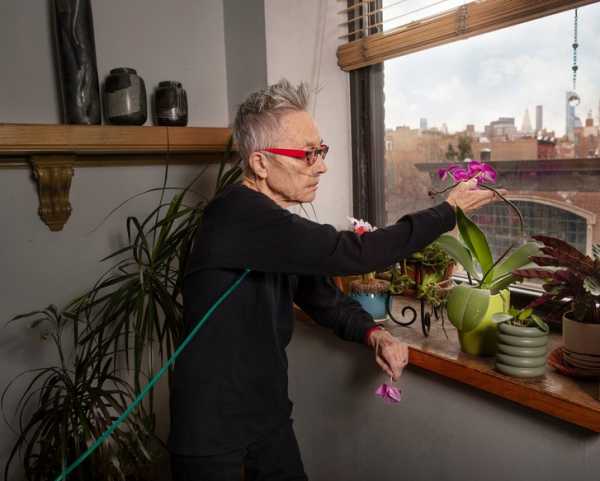
Photograph by Elinor Carucci for The New Yorker
Day 2
As we sat down, Hammer and Burke told me that, following our conversation the day before, they had started photographing Hammer’s body.
In “Tender Fictions,” you repeatedly quote a phrase: “ ‘I’ as a lesbian couple.” Could you explain it?
HAMMER: It’s a quote from Biddy Martin [the queer literary theorist and the president of Amherst College]. She argues that the only way you can be a lesbian is to be sexually involved. And I’m mixed. I can be a lesbian and not be involved with anybody. And I can be a lesbian with several lesbian lovers or one, or I could be bisexual with several lesbian lovers and male lovers. It’s enigmatic. I like the kinds of questions that aren’t clear.
Yesterday, when I was leaving, I quoted someone who had watched your movies and said, “She makes being lesbian look like such fun.” And you said, “But it is.” What makes it so fun?
HAMMER: To me, pleasure is in surprising, playing with someone else in a way you’re not expecting or allowing them in to play with you. A sense of “anything can go,” and we can go from traditional behaviors to joking, bringing ideas together, maybe ideas that wouldn’t normally be said. We’d both be laughing. That could lead to another thing. In the seventies, we were going further into understanding what are the politics of being gay, what are the politics of being in a relationship with a woman or women. This was a time of experimenting, of having two women at a time, finding out, as I did, how difficult it was to be doubly engaged, to be able to balance myself in a relationship. But the relationships were so different. I couldn’t give one up for the other, because one would bring me into politics and the other, a woman who’s twelve years older than me, was an artist I admire greatly but who’s married to a man. One would introduce me to what Leninism was. All these women had great influences on me.
And, when we got to the AIDS epidemic, something would keep me away from being part of ACT UP, because if I became part of ACT UP, I wouldn’t have room for my films.
Because it’s just so time-consuming.
HAMMER: And so necessary. But you only have—you only have one life to live, and what do I have the most to give?
BURKE: And then I started dragging you into the streets.
HAMMER: She took me into more politics.
BURKE: Civil rights, human rights.
How did that influence your work?
HAMMER: It really changed it. I wonder if I would have made stronger lesbian work if I’d never been involved in that, if I would have gone wilder and bigger in terms of more expression of gay life, of lesbian life. The other thing that was taking me in were the stories about the life of the poet Elizabeth Bishop. These older lesbians would have intriguing stories that I would never know about. Just spending time exploring their lives, and not worrying so much about whether they’re going to like what I do with them today—it was another way of giving myself pleasure. I like being an academic in some of that early work. I’m not really clear how long I would have continued that period of exploring sexuality [on film]. Don’t you often wonder?
But your recent work is also very tactile. It’s like you can actually feel what’s onscreen in addition to seeing it. Isn’t that a continuation of that sensuality from the early movies?
HAMMER: It is. With other ideas added for the audience to feel that sensuality. Back in the eighties, there was a woman watching “Dyketactics” in San Francisco, at the Larkin Theatre, sitting behind me, and she started crying. It turned out she thought she might be coming out. I said, “Welcome, it’s not a bad place to go.”
You’ve lived through so many generations of lesbian politics. You were first making movies in an era when butch and femme roles were frowned upon, then we saw a resurgence of butch and femme; there was a period when one didn’t dare suggest that a butch lesbian wanted to be a man, and then so many lesbians began transitioning that the butch seemed to be disappearing.
HAMMER: A lot of my lesbian friends were upset about so many butch friends of ours who were becoming trans, and I was always trying to explain to them: everybody gets to explore. But one thing is we don’t want to forget the lesbian, and we don’t want her to be lost. She might not even be known in twenty years, as a population or as a language. A mode of being, a vocabulary, a particular way we cut our hair—this is going to be lost if there’s no lesbian anymore. After a while, nobody will even remember.
I got money from Yale for my paper archives, and I decided that this money will go—through an annual award I have established—to lesbians and nowhere else. They are experimental artists. We don’t really know how things may change. At some point, it may be time to make it for lesbians and transgenders or queers.
BURKE: Remember, when you limited it to lesbian experimental filmmakers, you said, “How many are going to apply?” In the first year, there were seventy or something. This year there were ninety. People of color, all ages and ethnicities. It’s not a huge amount of money, but, for young filmmakers, it’s a start.
HAMMER: And maybe my death will draw more contributions. And then we would give more than one next year. I’m lucky enough that I was able to save enough in my life that I can give money to Florrie, and give all the money that my art work made to other people.
We said yesterday that this is an exit interview. Like when you leave a job and the human-resources department conducts an interview with you. My question is, What was your job?
HAMMER: My job was anything that I made up and decided to do. It was often around filmmaking, but sometimes it would be painting or making an installation or doing a performance. I wanted people to know what it was like to have cancer and not just see it on the screen but to see me there coughing and struggling and breathing and not breathing, so I did a piece which was a lot of work, and seventy people got to see it in a gallery. But then it led to more performances. It has been learning how to just follow my path. And, if I don’t get the money for a film, I move to another film. There was always another kind of film, a film that I just needed to make.
There’s a feature film—I wrote ninety pages for it—about women who pretended to be old. I had them make love in bed and they would sweat and have hot flashes.
Isn’t it called “Hot Flash”?
HAMMER: Yes. I made the first twenty minutes of it by shooting Friday, Saturday, and Sunday, rewriting all the script on Saturday, editing it together. But I never got the money for the film, which was like twenty-five thousand dollars then. It wasn’t that much. People spend a whole year trying to get their money together and make another film. I don’t believe in that. For me, there are so many ways of working that something new will always come along.
You mentioned that you appreciate older women. Even in “Nitrate Kisses,” there are women having sex who were much older than you were at the time.
HAMMER: I have appreciated older women more than younger women in terms of dating, in terms of friendships. Perhaps it was that they knew more. Perhaps they have better skills in lovemaking. The lines and wrinkles increase, bring in crevices and beauties in a way that we don’t see in cleansed-over skin. What is coming are possibilities of those who accept their bodies, not those who are just old and cover up their bodies. That’s who I want to be.
BURKE: And I think you were also wanting to break that myth that older women don’t have sex. You could show something on the screen that had not been shown and it was very shocking to some people.
HAMMER: We can also think of a way to speak about this late in life: as I’m dying, you can make love to a certain degree. I can’t say all the way, but one doesn’t have to give up on sexual experience with your lover as you’re progressing through the state of dying. How can we say that?
I think you just said it.
BURKE: You did.
What are you curious about, of things that you’re not going to see?
HAMMER: I hate to say the Presidential election, but, God damn, when do we get rid of him?
Sourse: newyorker.com
